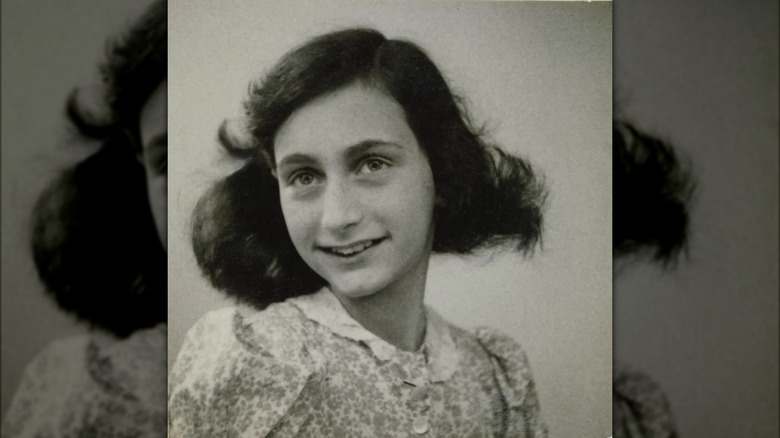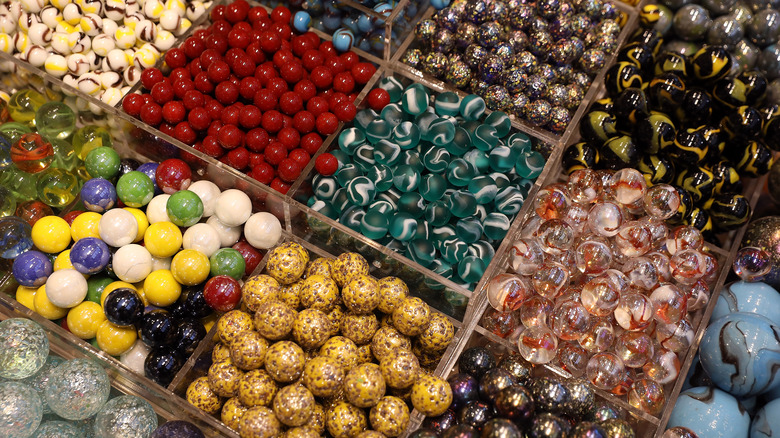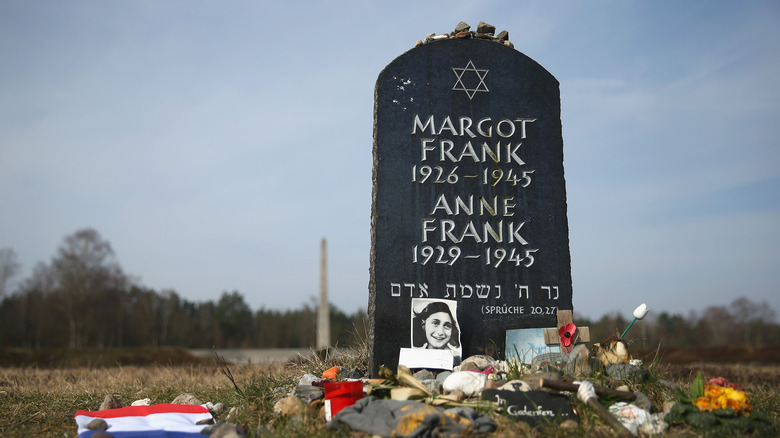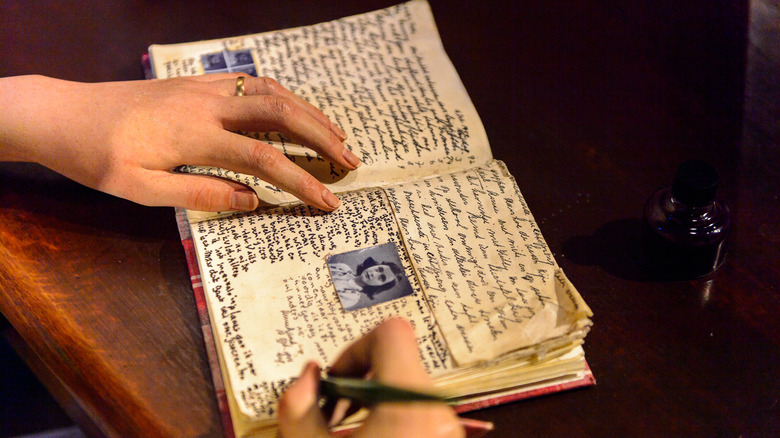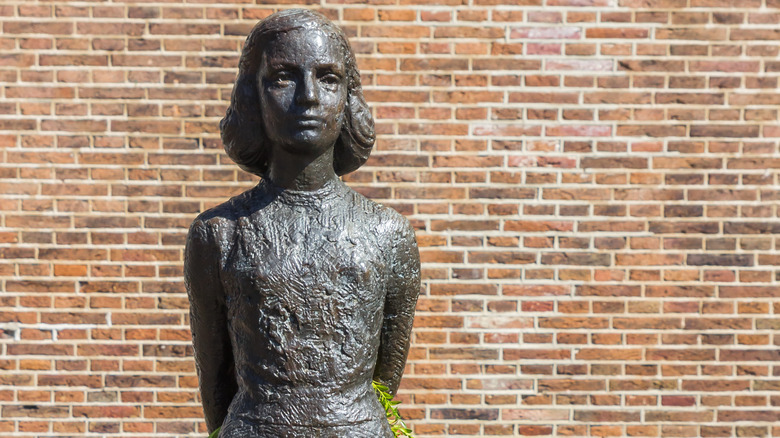What Anne Frank Left For Her Friend Before Going Into Hiding
A little girl known not only for her tragic demise but also for an all-too-familiar red-checkered diary that shed light on one of the darkest times in human history (via Anne Frank House). Without even saying her name, memories of high school history lessons on Anne Frank come to mind. With just a short, 16-year life ahead of her, Frank was born in Frankfurt am Main, Germany, in 1929 (via Anne Frank House).
Hailing from a Jewish family, the home she was born into quickly became anything but amidst the rise of Nazism and Adolf Hitler's anti-Semitic wrath (via CBS News). To protect his family from impending terror, Anne Frank's father Otto moved them to the Netherlands, where he started a company that made pectin, an ingredient used for making jams. Sadly, just as the Frank family began to settle in and feel at home, World War II began, and the Nazis invaded the Netherlands in 1940.
Into Hiding
In 1942, about two years after the invasion of the Netherlands, the Frank family went into hiding with the help of just a small circle of supporters (via CBS News). They hid in a cramped apartment above a warehouse but told everyone they knew they were moving to Switzerland. Thanks to their helpers, they were able to remain hidden for an additional two years until they were (possibly) betrayed — but more on that later.
Before they went into hiding in the apartment, Anne Frank, who was just a teenager, did not know she would never be returning to all she knew in the Netherlands — her friends, her toys, her life — so she had made arrangements to care for some of her possessions and left without many goodbyes. She later died in 1945 of typhus in a Bergen-Belsen concentration camp. While many of her belongings were rediscovered decades ago — like countless pictures of herself and her family, postcards, and other trinkets — certain artifacts have only recently just surfaced.
The Final Memories of a Teenage Girl
One of the supporters that helped the Frank family, albeit unknowingly, was the Kupers family, their non-Jewish neighbors in the Netherlands (via CBS News). They did not know where the Franks were truly going, but they agreed to care for their cat, Moortje, and some of Anne Frank's most prized possessions. Sadly, the Franks never came back for their beloved pet, nor Frank's trinkets.
A keepsake that only just surfaced in the last decade was a set of marbles kept safe by Frank's childhood friend, Toosje Kupers. Kupers held onto the marbles all this time, only thinking about telling a museum about them in 2014 when she was moving and uncovered them. She once explained in an interview that she never saw the marbles as special — rather, they were a memory of a past favor for a friend. Frank had told Kupers, "I'm worried about my marbles, because I'm scared they might fall into the wrong hands ... could you keep them for me for a little while?" Sadly, Kupers held onto the marbles for much longer than a little while. They can now be seen — along with a book and tea set Kupers was keeping for Frank — at the Kunsthal Art Gallery in Rotterdam (via The Times of Israel).
Foul Play
Anne Frank and Toosje Kupers were close friends who frequently played outside on the street they shared (via CBS News). The two young girls did not realize they would never see each other again, with just a box of marbles, books, and a tea set to keep the memory of their friendship alive. While families like the Kupers and dedicated supporters keeping them in the hidden apartment can be credited for the Frank family's prolonged survival, others close to home can possibly be blamed for their death.
Many people believe that the family's arrest and deportation to concentration camps were caused by betrayal, but only recently has there been a suspect named. A team of researchers, including a former FBI agent, studied the Frank family's case and revealed their findings this year, which found that a fellow Jewish member of the community outed their location in order to protect his own family (via BBC).
Possibly an Unfortunate Chance
Arnold van den Bergh lived in Amsterdam and was a member of the Jewish Council, a governing body that was forced to implement Nazi policies (via BBC). The group was disbanded in 1943, with its members being sent to concentration camps, but it has been hinted that Anne Frank's father Otto possibly knew that van den Bergh did them in due to an anonymous note shared with him. However, Otto allegedly did not reveal it publicly in order to not fan the already towering flames of anti-Semitism at the time. While some blame van den Berghfor the betrayal and outing of the Frank Family from their hiding place, others say it may have happened by chance (via BBC).
According to Frank's diary, shortly before the raid, there had been reports of food coupon fraud, which could have triggered police to come looking in the area. Further supporting this theory, the officers that found the Franks were not, in fact, tasked with looking for Jews in hiding but were police who dealt with cash-, security-, and possession-related crimes. Regardless of how they were caught, an entire family was lost, aside from father Otto, who went on to publish his daughter's diary (via CBS News).
Just a Girl
Among Anne Frank's other famed possessions are books, postcards, photos (of herself, her family, and movie stars), and of course, her marbles (via Anne Frank House). Toosje Kupers said Frank felt she had to get rid of things that were important to her so that others would not take them when she was gone. Sadly, neither of the friends knew at the time that her concern would not be necessary because she would not be returning. Although Frank's diary makes her seem wise beyond her years, the importance she placed on her toys rings of an innocence lost.
When it comes down to it, she was not an author or a famous diarist, a historian or a documentarist. She was just a girl who played in the street with her friends, read books, and collected postcards and celebrity photos. More importantly, she was just a girl who thought she would come home someday to her friends, her home, and her marbles.
